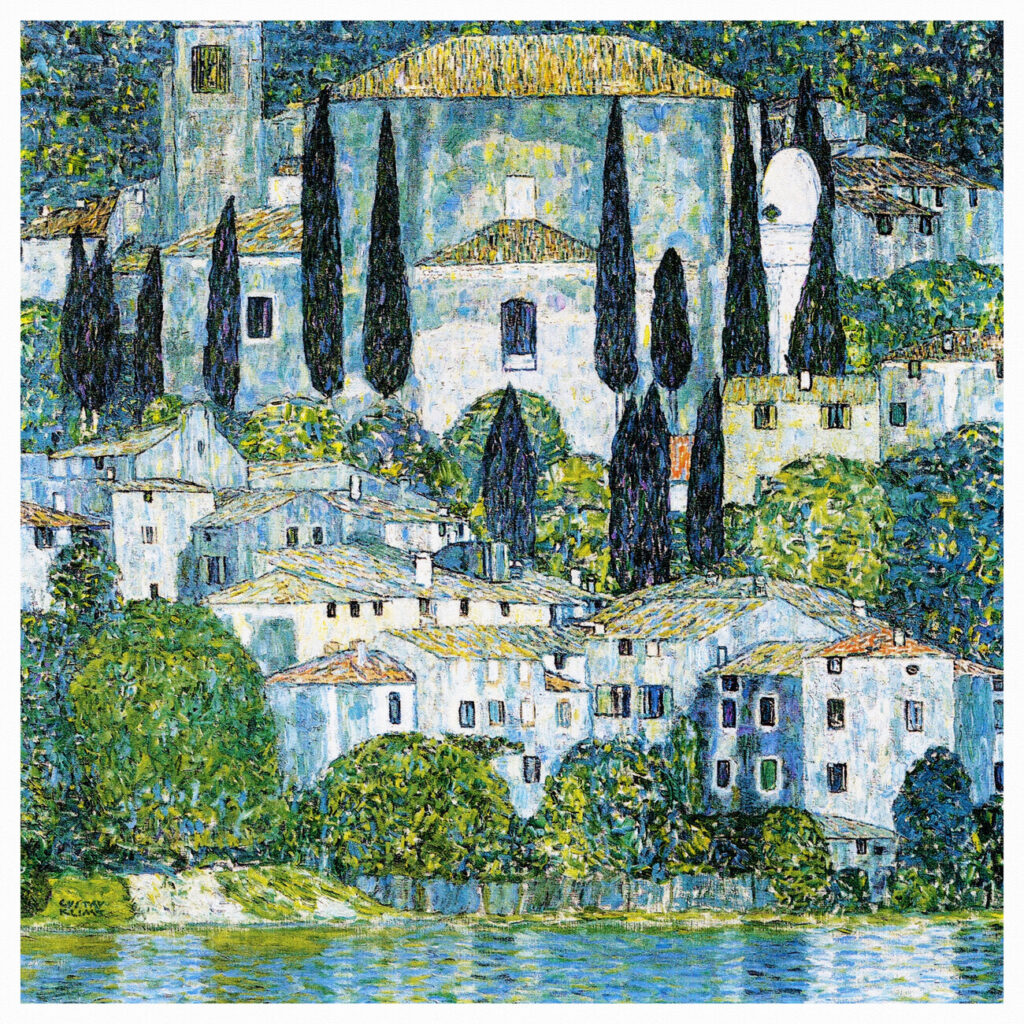Gustav Klimt, one of the most celebrated Austrian symbolist painters of the late 19th and early 20th centuries, is widely known for his distinctive style, blending sensuality, symbolism, and gold leaf to create works of extraordinary emotional depth and visual impression. Klimt’s career was marked by numerous masterpieces that explored themes of love, death, and the human condition, yet one of his lesser-known works, The Church of Cassone (1913), provides a unique insight into his ability to capture the essence of a landscape, offering a contrast to his more famous works.
The Context of “The Church of Cassone”
In 1913, Klimt created The Church of Cassone, a painting that depicted a tranquil, almost idyllic, scene of a village with a church nestled on the shores of Lake Garda, in northern Italy. While it may not have received the same level of attention as his iconic works like The Kiss (1907-1908) or Portrait of Adele Bloch-Bauer I (1907), The Church of Cassone remains a key example of Klimt’s versatility as an artist.
Lake Garda, the largest lake in Italy, is located in the northern part of the country, a region known for its stunning landscapes, charming villages, and cultural history. The church depicted in Klimt’s painting, the Church of Cassone, is situated in the small village of Cassone, near Malcesine, on the shores of Lake Garda. This area was a place of both beauty and inspiration for many artists in the late 19th and early 20th centuries, drawn to its dramatic scenery and the sense of peace and serenity that the landscape evokes.
Klimt’s The Church of Cassone serves as an ode to nature, architecture, and the peaceful coexistence of the two. By capturing the church against the shadow of the sparkling waters of Lake Garda, the artist blends elements of landscape painting with his unique approach to composition, color, and form. Though the subject matter is vastly different from the more erotically charged portraits and allegorical works for which Klimt is famous, the painting still carries the hallmark characteristics of his work: a careful attention to detail, an emphasis on patterns, and a profound emotional resonance.
Gustav Klimt’s Style and Artistic Evolution
Gustav Klimt was born in 1862 in Baumgarten, a suburb of Vienna, and went on to become one of the founding members of the Vienna Secession, a movement that sought to break away from the conservative standards of the traditional art academy and to promote a new, modern approach to art. His early works were influenced by the academic training he received at the Vienna School of Arts and Crafts, and he began his career by creating decorative murals and other commissioned works. However, it was Klimt’s later works, particularly his portraiture and symbolic paintings, that made him an icon of modernist art.
Klimt’s distinctive style evolved over the years, with a clear departure from the more conventional academic approach he started with. His mature style incorporated elements of symbolism, expressionism, and art nouveau, all of which were shaped by his exploration of themes such as sensuality, the human body, and the relationship between life and death. His use of gold leaf in many of his works, combined with ornate patterns, created a rich, almost otherworldly effect that was unlike anything seen in the art world at the time.
Despite the sensual and often provocative themes in many of his famous works, Klimt also had a deep connection to nature, which is evident in The Church of Cassone. In this landscape, the focus is less on the human form or emotional expression and more on the harmonious relationship between the natural world and the built environment.
The Landscape and Symbolism of “The Church of Cassone”
The painting’s depiction of the Church of Cassone offers a stark contrast to Klimt’s other works, as it focuses primarily on nature and architectural elements. The church, with its traditional stone structure, is nestled on the edge of Lake Garda, surrounded by lush greenery, while the soft ripples of the lake reflect the sky above. The interplay of light and water, combined with the towering peaks in the background, creates a serene and meditative atmosphere.
What stands out in this landscape is Klimt’s use of color. The rich, vibrant hues of the water, sky, and foliage come alive in a way that suggests a sense of movement, even within the stillness of the scene. The use of bold, yet delicate brushstrokes to depict the natural elements adds texture and depth, allowing the viewer to feel the wind and the coolness of the lake breeze.
The architecture of the church, although simplified in its design, is painted with a kind of reverence that suggests the deep connection between nature and manmade structures. Klimt’s portrayal of the church as part of the landscape suggests that the built environment is not separate from the natural world but is an integral part of it. This connection between man and nature is a recurring theme in Klimt’s work, and The Church of Cassone offers a peaceful expression of this idea.
The colors in the painting also carry a sense of symbolism. The contrast between the cool blues of the lake and the warm, earthy tones of the church suggests a balance between the serenity of nature and the stability of human creation. The bright, almost golden light that bathes the scene hints at a spiritual dimension, as if the landscape itself is imbued with divine energy.
In many ways, Klimt’s work reflects a fascination with the intersection of the human world and the natural world, with The Church of Cassone serving as a quiet meditation on this theme. The church, a symbol of human devotion and spirituality, is shown as part of the landscape, as though it has grown naturally from the earth itself, embracing its surroundings rather than imposing itself upon them.
The Affect of “The Church of Cassone” on Klimt’s Legacy
While The Church of Cassone may not have the same level of recognition as some of Klimt’s more famous works, it is an important piece in understanding the breadth of his artistic vision. The painting showcases Klimt’s ability to adapt his style to a variety of subjects, from erotic portraiture to symbolic allegories, and to produce works that reflect both his personal artistic exploration and his deep understanding of the world around him.
The painting is also a testament to Klimt’s ability to evoke emotion through the depiction of natural landscapes. In contrast to the intense emotion often associated with his portraiture and allegorical works, The Church of Cassone offers a more subdued but equally powerful expression of the artist’s connection to nature and his ability to convey beauty through the simplest of subjects.
In the larger context of Klimt’s oeuvre, The Church of Cassone provides a glimpse into his relationship with the natural world. It’s a rare example of the artist focusing on a landscape without the added emotional drama of human figures, yet it remains infused with the same sense of reverence for beauty that is evident in his more famous works.
Impression
Gustav Klimt’s The Church of Cassone is an understated yet deeply meaningful work that showcases the artist’s exceptional ability to capture the essence of both natural beauty and human creation. Set against the tranquil backdrop of Lake Garda, the painting emphasizes the harmony between manmade structures and the landscape, illustrating Klimt’s belief in the interconnectedness of all things. As an artist known for his exploration of themes such as love, death, and sensuality, Klimt’s portrayal of a simple Italian village church on the shores of a lake serves as a poignant reminder of his ability to evoke emotion through diverse subjects, from portraiture to serene landscapes. Though The Church of Cassone may not carry the same fame as his iconic works, it stands as a testament to Klimt’s versatility, his deep connection to nature, and his ongoing influence in the world of art
No comments yet.








